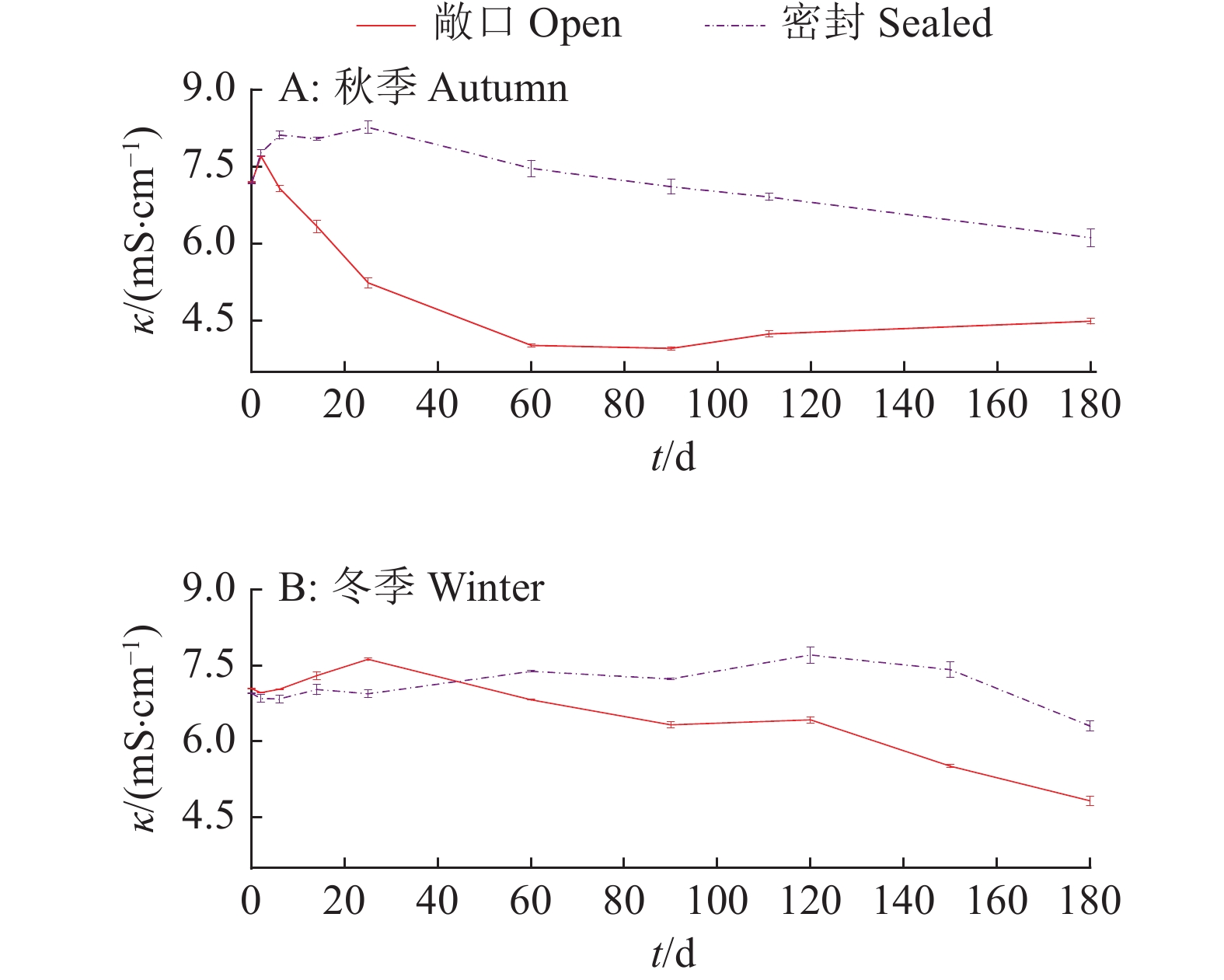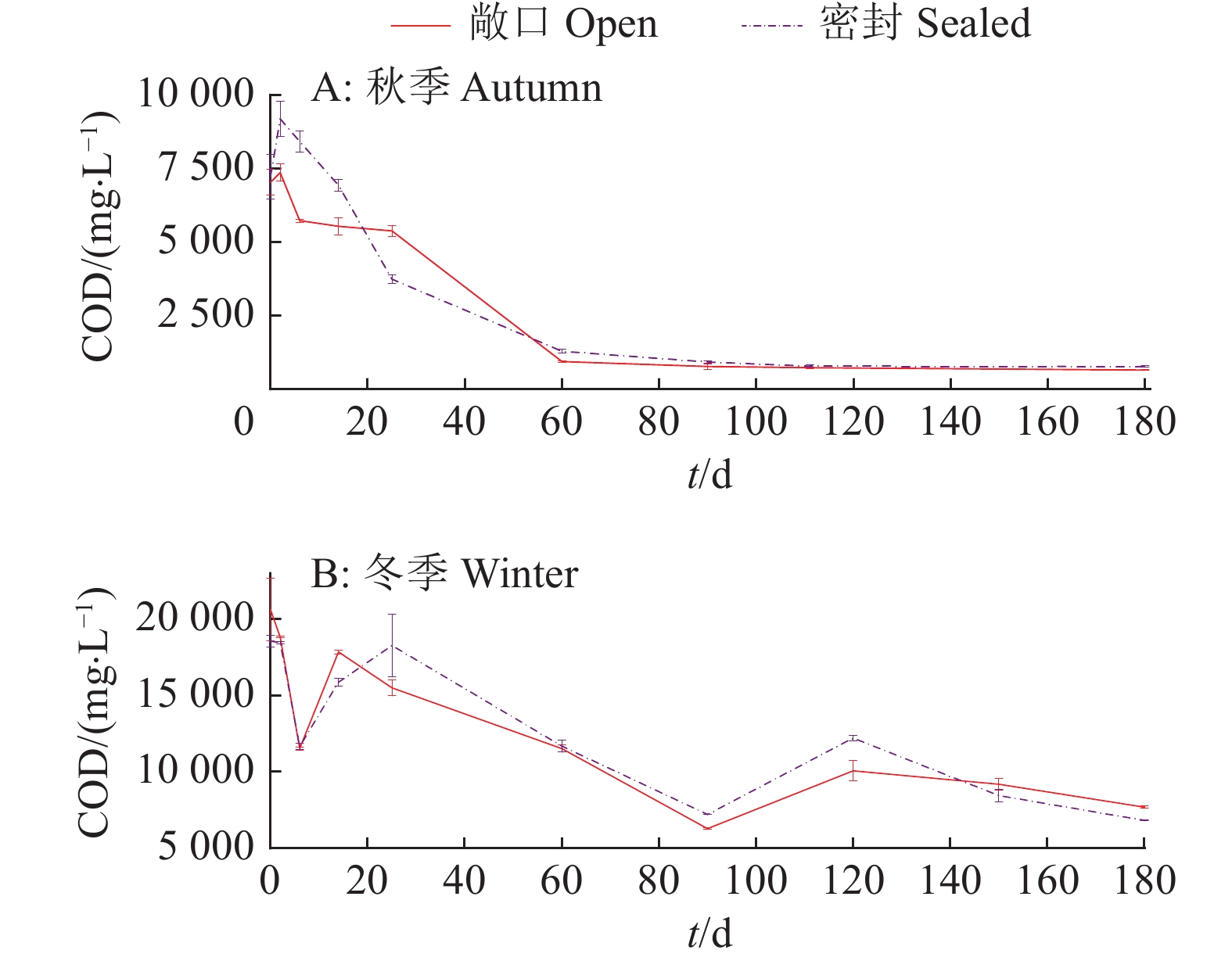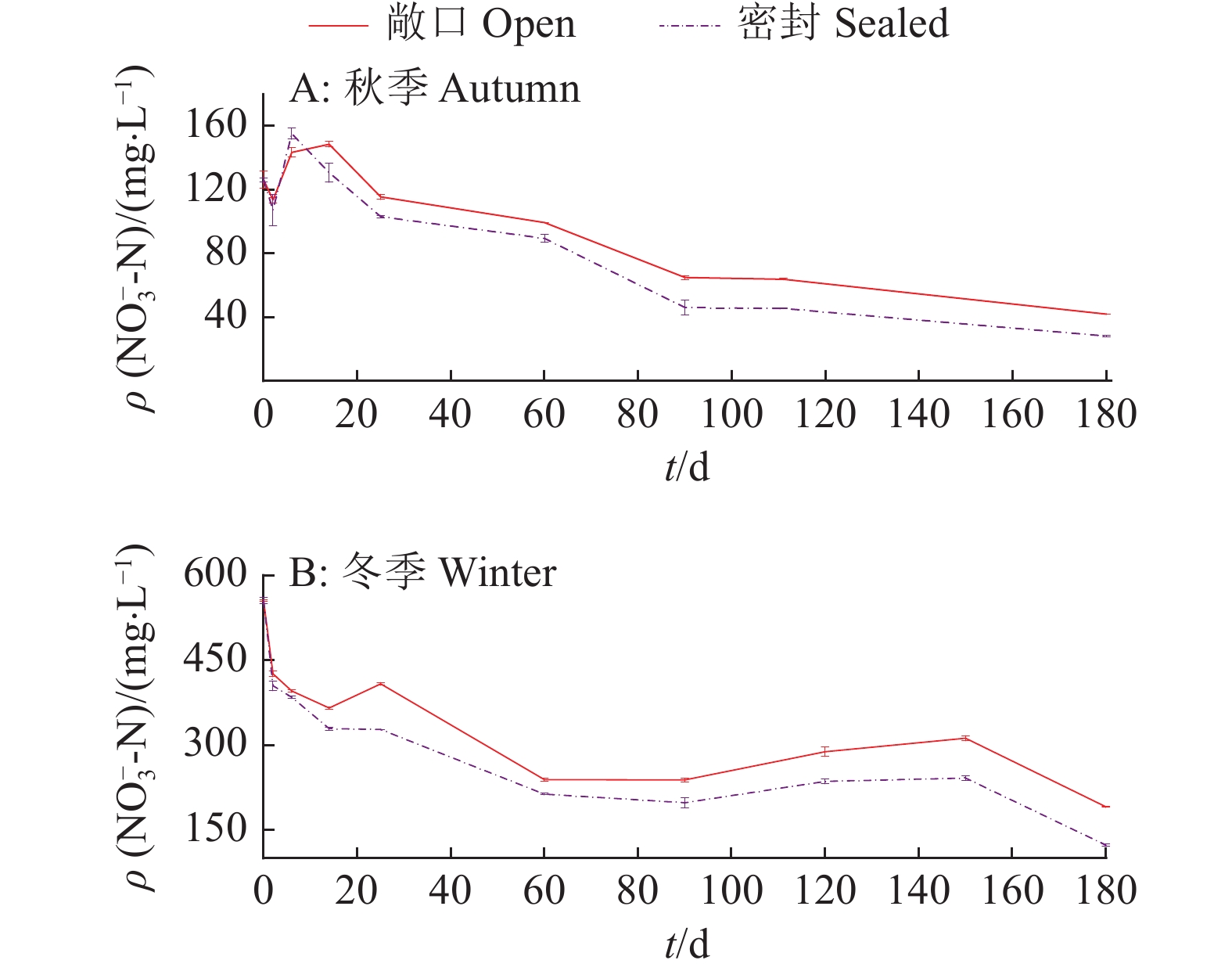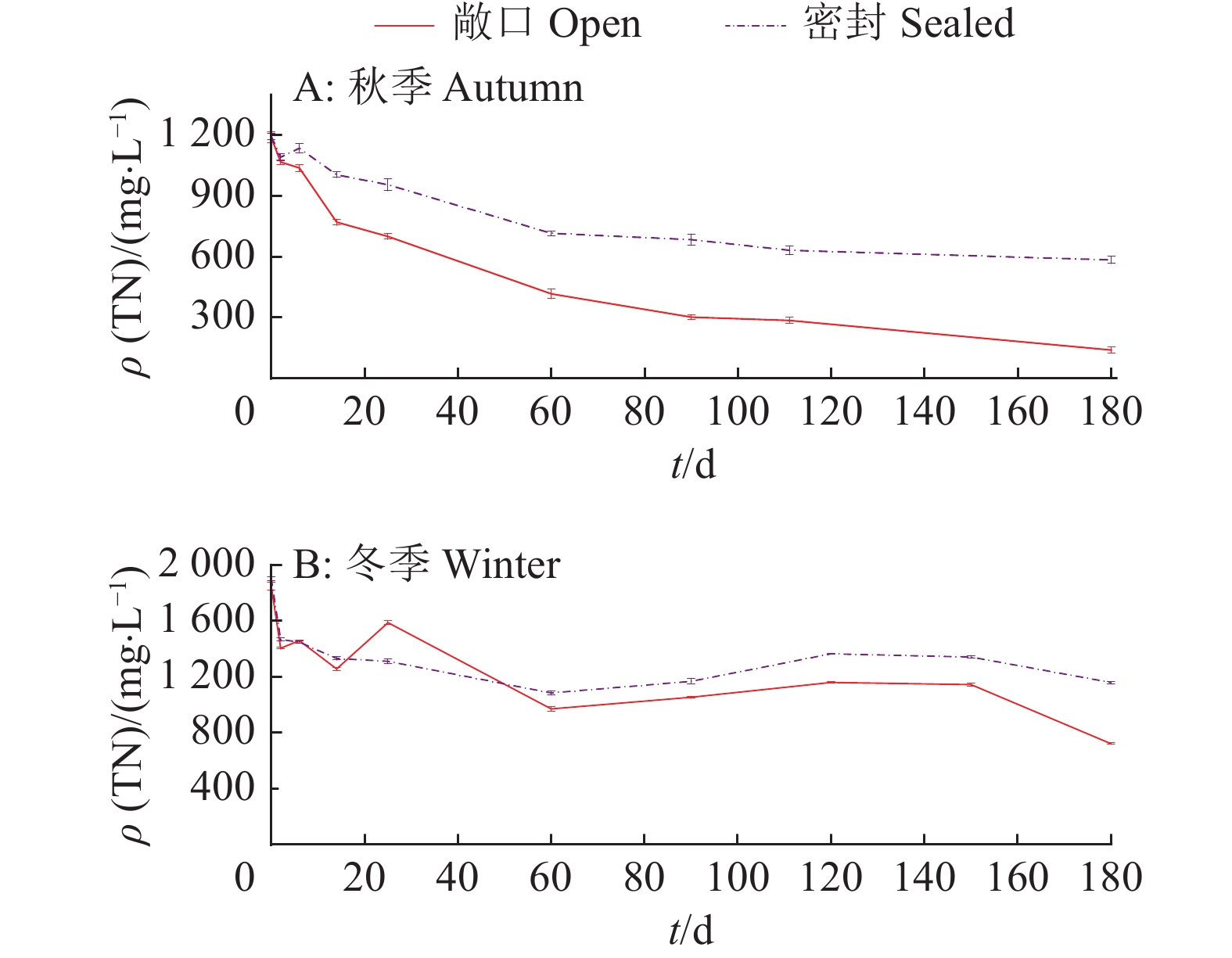Effect of different storage methods on physic-chemical properties of pig slurry
-
摘要:目的
针对猪粪水贮存过程中氮素大量损失的问题,比较秋季和冬季条件下敞口和密封贮存对猪粪水贮存过程中理化特性的影响,以便为猪粪水贮存还田提供理论参考。
方法在实验室条件下,比较了秋季和冬季敞口与密封贮存对猪粪水贮存过程中物质转化、氮素损失及无害化的影响,分析了猪粪水pH、电导率(Electrical conductivity,κ)、化学需氧量(Chemical oxygen demand,COD)、种子发芽率及NH4+-N、NO3−-N、总氮(Total nitrogen,TN)和重金属(As、Zn、Cu、Pb和Cd)含量的变化。
结果猪粪水贮存过程中,pH先增加后保持相对稳定,κ、COD及TN、NO3−-N和重金属含量均逐渐降低,NH4+-N含量先增加后降低,种子发芽率逐渐增加;贮存后猪粪水中无机氮占比明显增加(冬季敞口贮存除外),除Cu和Zn含量未达到《农田灌溉水质标准》(GB 5084—2021)要求外,As、Pb和Cd含量均达到无害化和稳定化要求;贮存造成氮素损失严重,秋季和冬季敞口贮存猪粪水的氮素损失率分别为79.44%和52.60%。与敞口相比,密封贮存降低了猪粪水pH,显著减少了贮存过程中氮素损失,降低了Zn含量,特别是显著减少了NH4+-N损失,秋季和冬季贮存后猪粪水氮素损失率较敞口贮存分别减少36.14和21.30个百分点;贮存后猪粪水κ显著高于敞口贮存,种子发芽率略低,对其他重金属(As、Cu、Pb和Cd)含量无显著影响。
结论尽管敞口贮存简单方便,但氮素损失严重,降低了贮存后猪粪水的肥料价值,故在有条件的地区应鼓励养殖场进行猪粪水密封贮存。
Abstract:ObjectiveAiming at the great loss of nitrogen during swine slurry storage process, effects of open and sealed storage on the physic-chemical properties of swine slurry during the storage process were compared in autumn and winter to provide a theoretical reference for swine slurry storage and return to the field.
MethodThe effects of open and sealed storage on material transformation, nitrogen loss and harmlessness of pig slurry storage were compared in autumn and winter under laboratory condition. The changes of pH value, electrical conductivity (κ), chemical oxygen demand (COD), NH4+-N content, NO3−- N content, total nitrogen (TN) content, seed germination rate and heavy metal (As, Zn, Cu, Pb and Cd) contents were analyzed.
ResultThe pH value first increased and then remained relatively stable, κ, COD, the contents of TN, NO3−-N and heavy metals gradually decreased, NH4+-N content first increased and then decreased gradually, and the seed germination rate gradually increased during the storage of pig slurry. After storage, the proportion of inorganic nitrogen in pig slurry increased significantly (Except for winter open storage). Except Cu and Zn did not meet the requirements of “Water Quality Standard for Farmland Irrigation” (GB 5084—2021), As, Pb and Cd met the requirements of harmlessness and stabilization. However storage also caused serious nitrogen loss, with the nitrogen loss rates of 79.44% and 52.60% respectively in autumn and winter under open storage. Compared with open storage, sealed storage reduced the pH value of pig slurry, significantly reduced the nitrogen loss and Zn content during storage, especially the NH4+-N loss. The nitrogen loss rate of pig slurry after storage in autumn and winter decreased by 36.14 and 21.30 percentage points respectively compared with open storage. However, after storage, the κ of pig slurry was significantly higher than that of open storage, seed germination rate was slightly lower, and there was no significant effect on the contents of other heavy metals (As, Cu, Pb and Cd).
ConclusionAlthough open storage is simple and convenient, but the nitrogen loss is serious, which reduces the fertilizer value of pig slurry after storage. Therefore, farms should be encouraged to store pig slurry in sealed condition.
-
Keywords:
- Storage method /
- Pig slurry /
- Physicochemical characterization /
- Nitrogen loss /
- Open storage /
- Sealed storage
-
-
图 7 猪粪水贮存过程对种子发芽率的影响
各图中,相同时间柱子上方的不同小写字母表示处理间差异显著(P<0.05, Duncan’s法)
Figure 7. Effect of storage process of pig slurry on seed germination rate
In each figure, different lowercase letters on the bars of the same time indicate significant differences among different treatments(P<0.05, Duncan’s method)
表 1 贮存前后猪粪水中氮素形态占比变化1)
Table 1 Changes of nitrogen form percentage in pig slurry obtained before and after storage
季节
Season处理
Treatment贮存前占比/%
Percentage before storage贮存后占比/%
Percentage after storage氮素损失率/%
Nitrogen
loss rateNH4+-N NO3−-N NH4+-N +
NO3−-NNH4+-N NO3−-N NH4+-N +
NO3−-N秋季
Autumn敞口
Open43.64±1.50 10.62±0.57 54.26±1.29b 63.63±2.21 30.03±1.25 93.66±1.99a 79.44±2.19a 密封
Sealed41.23±1.88 10.57±0.29 51.80±1.56b 75.98±2.91 4.81±0.28 80.79±2.10c 43.30±2.66c 冬季
Winter敞口
Open42.70±2.05 30.05±1.34 72.75±1.82a 38.34±0.91 26.38±0.84 64.72±0.89d 52.60±2.91b 密封
Sealed38.78±2.05 29.17±0.66 67.95±1.16a 76.65±0.95 10.59±0.44 87.24±0.85b 31.30±1.48d 1) 表中数据为平均值±标准误,n=3;同列数据后的不同小写字母表示处理间差异显著(P<0.05,Duncan’s法)
1) Data in table are means ±SE, n=3; Different lowercase letters in the same column indicate significant differences among different treatments (P<0.05, Duncan’s method )表 2 猪粪水贮存过程中重金属含量变化1)
Table 2 Changes of heavy metal contents during the storage process of pig slurry
ρ/(mg·L−1) 季节
Season处理
TreatmentAs Zn 0 d 60 d 120 d 180 d GB 5084—
20210 d 60 d 120 d 180 d GB 5084—
2021秋季
Autumn敞口
Open0.05±0.00a 0.03±0.00ab 0.04±0.00a 0.04±0.00a ≤0.05 12.58±0.81c 6.68±0.25c 5.53±0.12c 3.28±0.16c ≤2.00 密封
Sealed0.03±0.00b 0.04±0.00a 0.04±0.00a — 14.28±0.66b 4.58±0.08d 2.58±0.03d 2.53±0.11d 冬季
Winter敞口
Open0.03±0.00c 0.02±0.00c 0.02±0.00c 0.01±0.00c 52.93±4.47a 48.53±3.37a 16.83±1.01a 10.93±0.62a 密封
Sealed0.03±0.00c 0.03±0.00b 0.03±0.00b 0.02±0.00b 48.63±2.90a 23.73±1.66b 8.93±0.34b 6.03±0.23b 季节
Season处理
TreatmentCu Pb Cd 0 d 120 d 180 d GB 5084—
20210 d 120 d GB 5084—
20210 d 120 d GB 5084—
2021秋季
Autumn敞口
Open2.76±0.19bc 2.01±0.02a 0.56±0.02c ≤0.50 0.11±0.01a — ≤0.20 0.05±0.00 — ≤0.01 密封
Sealed2.42±0.21c 1.93±0.13ab 0.63±0.01b 0.11±0.03a — 0.04±0.00 — 冬季
Winter敞口
Open3.03±0.07b 1.68±0.11b 1.04±0.11a 0.08±0.00b — — — 密封
Sealed3.61±0.16a 0.58±0.01c 0.39±0.01d 0.10±0.01 a 0.02±0.00 — — 1)表中数据为平均值±标准误,n=3;同列数据后的不同小写字母表示处理间差异显著(P<0.05, Duncan’s法);“—”表示未检测到
1) Data in table are means ±SE, n=3; Different lowercase letters in the same column indicate significant differences among different treatments (P<0.05, Duncan’s method); “—” indicates not detected -
[1] 国家统计局. 中国统计年鉴: 2021[M]. 北京: 中国统计出版社, 2021. [2] 徐鹏翔, 沈玉君, 丁京涛, 等. 规模化养猪场粪污全量收集及贮存工艺设计[J]. 农业工程学报, 2020, 36(9): 255-262. [3] 国务院办公厅. 国务院办公厅关于加快推进畜禽养殖废弃物资源化利用的意见: 国办发〔2017〕48号[A/OL]. (2017-05-12)[2021-08-13]. https://huanbao.bjx.com.cn/news/20170613/830752.shtml. [4] 农业部. 农业部关于印发《畜禽粪污资源化利用行动方案(2017—2020年)》的通知[A/OL]. (2017-07-07)[2021-08-13]. http://www.moa.gov.cn/nybgb/2017/dbq/201801/t20180103_6134011.htm. [5] 全国畜牧总站, 中国饲料工业协会, 国家畜禽养殖废弃物资源化利用科技创新联盟. 畜禽养殖废弃物资源化利用主推技术模式[N]. 农民日报, 2017-12-6(6). [6] 孔凡克, 鞠鑫鑫, 杨守军, 等. 种养结合技术在畜禽粪水处理与资源化利用中的应用[J]. 猪业科学, 2017, 34(8): 106-107. doi: 10.3969/j.issn.1673-5358.2017.08.035 [7] 张朋月, 丁京涛, 孟海波, 等. 牛粪水酸化贮存过程中氮形态转化的特性研究[J]. 农业工程学报, 2020, 36(8): 212-218. [8] 马艳茹, 孟海波, 沈玉君, 等. 粪水酸化储存还田应用效果[J]. 农业工程学报, 2020, 36(15): 245-251. doi: 10.11975/j.issn.1002-6819.2020.15.030 [9] MANSYUR M, CHOI H L. Changes of physico–chemical properties of pig slurry during storage[J]. Media Peternakan, 2011, 34(3): 179-183. doi: 10.5398/medpet.2011.34.3.179
[10] 姜晨润, 孙靖博, 李华, 等. 规模化养猪场粪便贮存方式及土壤承载力[J]. 农业工程, 2019, 9(1): 35-37. [11] 丁京涛, 张朋月, 赵立欣, 等. 养殖粪水长期贮存过程理化特性变化规律[J]. 农业工程学报, 2020, 36(14): 220-225. [12] 朱海生, 董红敏, 栾冬梅, 等. 贮存高度和锯末覆盖厚度对猪粪NH3和温室气体排放量及其增温潜势的影响[J]. 农业环境科学学报, 2019, 38(4): 937-943. [13] XUE S K, CHEN S, HERMANSON R E. Wheat straw cover for reducing ammonia and hydrogen sulfide emissions from dairy manure storage[J]. Transactions of the ASAE, 1999, 42(4): 1095-1102. doi: 10.13031/2013.13257
[14] VANDERZAAG A C, GORDON R J, GLASS V M, et al. Floating covers to reduce gas emissions from liquid manure storages: A review[J]. Applied Engineering in Agriculture, 2008, 24(5): 657-671. doi: 10.13031/2013.25273
[15] PAIN B F, MISSELBROOK T H, REES Y J. Effects of nitrification inhibitor and acid addition to cattle slurry on nitrogen losses and herbage yields[J]. Grass and Forage Science, 1994, 49(2): 209-215. doi: 10.1111/j.1365-2494.1994.tb01994.x
[16] SIMS J T, LUKA-MCCAFFERTY N J. On-farm evaluation of aluminum sulfate (alum) as a poultry litter amendment: Effect on litter properties[J]. Journal of Environmental Quality, 2002, 31(6): 2066-2073. doi: 10.2134/jeq2002.2066
[17] SØRENSEN P, ERIKSEN J. Effects of slurry acidification with sulphuric acid combined with aeration on the turnover and plant availability of nitrogen[J]. Agriculture Ecosystems & Environment, 2009, 131(3/4): 240-246.
[18] PEREIRA J L S, FIGUEIREDO V, PINTO A F M A P, et al. Effects of biochar and clinoptilolite on composition and gaseous emissions during the storage of separated liquid fraction of pig slurry[J/OL]. Applied Sciences, 2020, 10(16): 5652. [2021-09-20]. https://doi.org/10.3390/app10165652
[19] 刘美玲. 生物炭与菌剂对猪粪氨气、甲烷和氧化亚氮排放的影响[D]. 保定: 河北农业大学, 2020. [20] 靳红梅, 付广青, 常志州, 等. 猪、牛粪厌氧发酵中氮素形态转化及其在沼液和沼渣中的分布[J]. 农业工程学报, 2012, 28(21): 208-214. [21] 生态环境部. 国家市场监督管理总局. 农田灌溉水质标准: GB 5084—2021[S]. 北京: 生态环境部, 2021. [22] POPOVIC O, JENSEN L S. Storage temperature affects distribution of carbon, VFA, ammonia, phosphorus, copper and zinc in raw pig slurry and its separated liquid fraction[J]. Water Research, 2012, 46(12): 3849-3858. doi: 10.1016/j.watres.2012.04.020



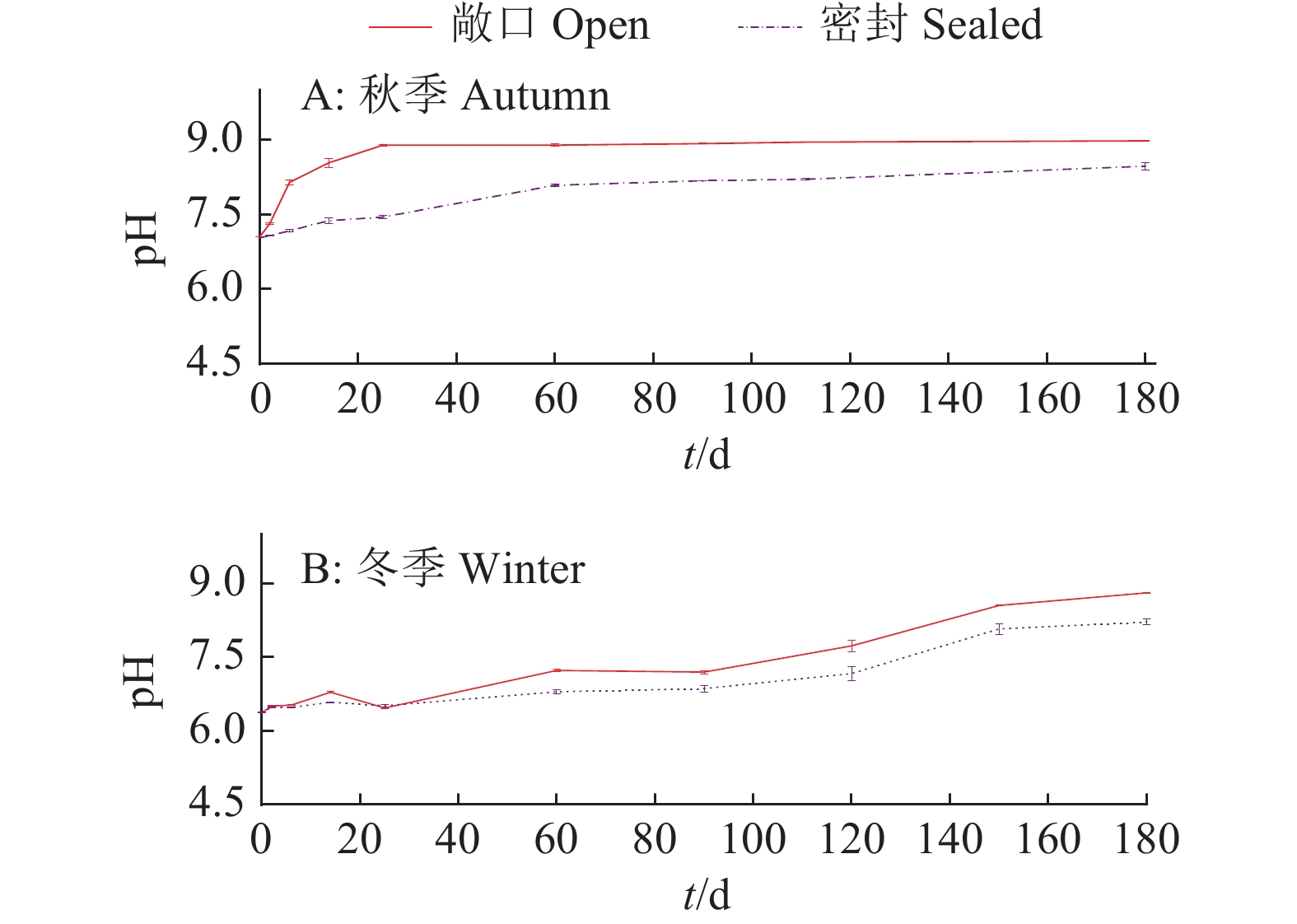
 下载:
下载:
